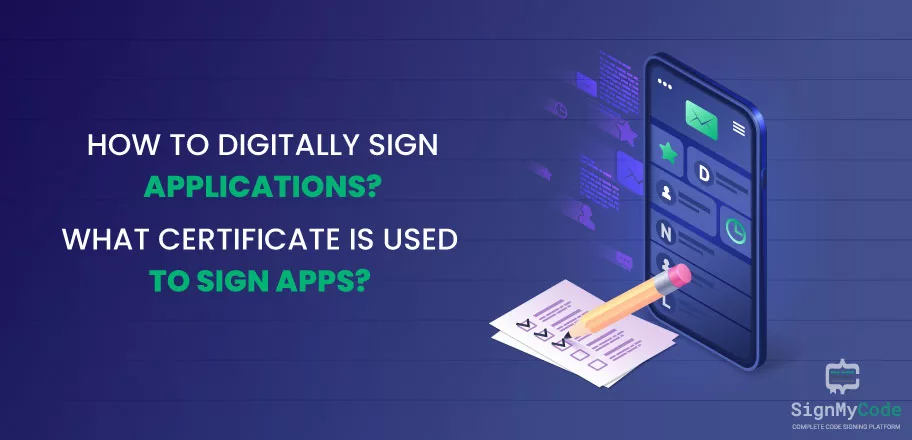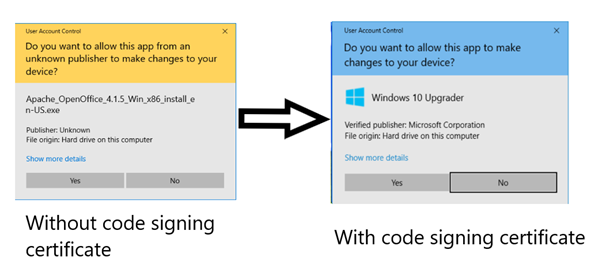How to Digitally Sign Applications? What Certificate Is Used to Sign Apps?

In the security domain, various digital certificates get used by businesses to secure their IT environment. But, when it comes to finding the certificate to digitally sign applications, most people need help finding a reliable solution.
Due to it, some select the wrong certificate, creating complexities and not fulfilling their requirements.
But, there will be no complexities for you, as by reading further, you will understand what type of certificate you need and how to digitally sign.
The Primary Requirement To Digitally Sign Applications
After the application development and testing, software publishers have to release software for public usage. But, in between the app launch and final release stage, a very crucial process takes place, and that is digitally signing the applications. And for successfully perform it, a Code Signing Certificate gets used.
Code Signing Certificate is a logical authenticated file containing the key pair, root CA and publisher’s details. Its primary purpose is to secure the application’s source code from threat actors, such as hackers, script kiddies, organized hacking groups, and other cyber-attackers. And to fulfill a such requirement,
Code Signing Certificates utilizes the PKI (Public Key Infrastructure), hashing, and encryption mechanisms.
Firstly, the certificates create a hash digest of the code and then encrypt it using the private key. Further, it embeds publisher details with the software and provides a signed application as output.
After it, whenever any end-user downloads or installs the app, the system verifies its authenticity and provides a zero warning process. However, to execute all such operations, you must Purchase a Code Signing Certificate and get it validated by a Certificate Authority.
To avail of such a digital certificate, you can follow the following steps:
Step 1: Visit the website of an authorized Code Signing Certificate Provider, like SignMyCode.
Step 2: Select the type of certificate you need and make payment.
Step 3: Pass the vetting process, receive the certificate and secure your applications.
And to select a perfect Code Signing Certificate, let’s look at its types, platform compatibility, and requirements.
The Types and Users of Code Signing Certificate
Code Signing Certificate comes in three types concerning its primary user, vetting procedure, features, and benefits.
Individual Code Signing Certificate
Individual Validation Code Signing Certificate is an essential digital certificate used by solo freelancers and independent developers/publishers to secure their applications. If any developer who doesn’t work in an organization has to align its application with significant security standards, an IV certificate is an appropriate choice.
The vetting process to avail Individual validation certificate is both seamless and quick, as it gets issued within 1 to 5 days.
You need to provide the following documents to Certificate Authority to get IV authorized:
- Government Registered ID, such as Passport, Driving License, or Military ID.
- Financial Documents having your full name similar to government ID, such as Bank Statements, Mortgage Statement, Credit/Debit Card Statement
- Non-financial Documents, such as Water Bills, Electricity Bill, Birth Certificate
You must keep all the mentioned documents handy before participating in the IV validation process and make certain information on all evidence is correct. Further, once CA issues you the IV Code Signing Certificate, you can benefit from the following:
- Boost the publisher’s reputation across digital platforms
- Removal of Unknown Publisher Warning
- Tamper-proofing of code, preventing unauthorized alteration
Standard Code Signing Certificate
Standard Code Signing Certificate is for firms developing and publishing software for users across the internet and intranet portals. Sometimes, it is also known as Organization Validation (OV) Code Signing Certificate, as CA verifies the company’s legitimacy before issuing the OV certificate.
Furthermore, once the company signs an application with it, operating systems and browsers don’t display any warning to end-users.
Moreover, it helps organically improve the organization’s reputation on online app stores, repositories, browsers, and operating systems.
To avail of an OV Code Signing Certificate, the applicant company has to wait for 1 to 5 days after submitting the following documents:
- Official government-registered company ID
- Physical Address of the organization
- Telephone Number
- Legal Opinion Letter/Dun & Bradstreet Report
After receiving the documents, Certificate Authority will verify the details with the government or registered third-party database. And you will receive a verification call before the certificate issuance.
Extended Validation Code Signing Certificates
EV Code Signing Certificates are the most popular among organizations due to the ability to eliminate Microsoft Defender SmartScreen warnings. It’s the only certificate that assures us to do so, along with additional security to protect the private key from unauthorized persons.
In addition, an EV certificate is also only for enterprises, but with an additional condition, the firm must be active and registered for a minimum of three years.
Furthermore, to obtain an EV Code Signing Certificate, the applicant company must provide the following documents and wait for 3 to 5 days for verification.
- Government ID
- Operational Existence Proof
- Full Physical Address, including Pincode
- Telephone Number
- Employment Proof of the person applying for the certificate on behalf of the organization
To validate all your documents, CA uses a registered database and calls the person for final verification. And once you receive the EV certificate, you can leverage top-notch benefits, such as:
- Organization status will get changed to legitimate instantly
- Customers will not encounter any installation-associated warning
- The private key will get protected from unauthorized access, as CA provides it in an external USB for EV certificates only.
Platform Compatibility, Requirements, and Tools To Digitally Sign Applications
In accordance with the application development platform and operating system, the tools and compatibility differ in utilizing a Code Signing Certificate.
Microsoft Windows
If you need to Sign Windows-based application or are utilizing Microsoft Windows OS, you can use any IV, OV, and EV Code Signing Certificate. You will be required to install the Software Development Kit from Microsoft to access the application signing utility tool (SignTool).
To sign an application on the Windows operating system, you must follow the below steps:
Step 1: Store the certificate on the local machine in PFX format and install Microsoft SDK.
Step 2: Open the command prompt with administrator controls.
Step 3: Execute the appropriate command from the following:
To only sign the application package:
SignTool sign /fd SHA256 /a /f Certificate.pfx /p password AppFilePath.appxTo Sign and Timestamp the application package:
SignTool sign /fd hashAlgorithm /a /f Certificate.pfx /p password /tr timestampServerUrl AppFilePath.appxRemember that you cannot add a timestamp to an application after signing it. If you want your application to remain valid after certificate expiration, then you must use the sign and timestamp command.
Java
You can use any Code Signing Certificate to sign Java-based files. But, you must install Java Development Kit before executing the signing procedure, as it contains the jarsigner tool. In addition, you must store the code signing certificate in the keystore to let Jarsigner perform its functions.
Further, perform the following steps to sign a JAR application file.
Step 1: Open the command prompt on a Windows machine.
Step 2: Run the following command and replace the keywords with your file, certificate, password, and timestamp server URL.
jarsigner -tsa TimeStampServerURL -keystore Path_To_Keystore.jks -storepass YourPassword Path_To_File.jar YourAliasAdobe
If you don’t sign Adobe Air applications, browsers, and operating systems will warn users, or it can even block the installation. Therefore, it’s essential for every developer/publisher always to sign an Adobe-based app.
The primary requisite to sign Adobe apps is the AIR SDK. Once you install it, open the command prompt and navigate to its directory location on the local machine. Then, move further to the sub-directory containing the application’s source file in XML format and run the below command:
adt -package -storetype pkcs12 -Keystore "Path_To_Certificate.pfx" "Path_To_AdobeFile.air" "AdobeApplication.xml"iOS & macOS
To sign an application on the macOS, you can utilize any Code Signing Certificate. You can digitally sign the application through the in-built terminal and codesign command. In addition, you can use the following command to sign the installer package:
productbuild --distribution Product.dist --sign <identity> Product.pkgHowever, for the Apple App Store and Mac App Store, you must require the following things:
- A valid Apple Developer Program Account
- Apple issued certificate to distribute applications on the mac store for devices with enabled gatekeeper functionality.
Other Primary Platforms
Besides Java, Adobe, Windows, and Apple OS, you can utilize a Code Signing Certificate comes in the following versions for different platforms:
- Microsoft Authenticode Code Signing Certificate
- PowerShell Code Signing Certificate
- Visual Studio Code Signing Certificate
Additionally, whenever you have to purchase a Code Signing Certificate, list your platform and app requirements, then only move forward with the procedure.
Before and After Using The Code Signing Certificate for Application Security
There are many myths that Code Signing Certificate doesn’t make any difference. But, it’s not true, as when you digitally sign the application, its authenticity and security get highly solidified. As shown in the below image, when the user tries to install a non-signed application, the system displays a warning.
And when the user attempts to install an app with a digital signature, a no-warning installation gets executed.
Therefore, you should always digitally sign your applications.

Why Experts Prefer Comodo EV Code Signing Certificate?
If you search online for reviews and suggestions on Comodo EV Code Signing Certificate, you will see experts recommending it for professional use. And there are many reasons why the Comodo EV certificate is so popular.
Let’s have a look at its features and advantages:
- Every OS, browser, and digital platform recognizes comodo and publishers authenticated by it as legit.
- Comodo provides the private key in a hardware token for the EV certificate to prevent unauthorized access and usage.
- It helps to align with all the CA/B and other necessary industry standards.
- It prevents Unknown Publisher and Microsoft Defender SmartScreen warnings.
- You can prefer it for any executable file format and on any platform, including Java, Windows, PowerShell, and more.
Conclusion
Code Signing Certificate is the only and most reliable digital certificate to sign applications. It helps secure the source code, improve the publisher’s reputation, and build user confidence in the software. In addition, it is compatible with all digital platforms, including major operating systems and software development kits, helping developers to sign any application seamlessly.
Every developer and software publisher must obtain a Code Signing Certificate to comply with new-age industry and security standards. And it will support to increase in overall application protection and productivity.

